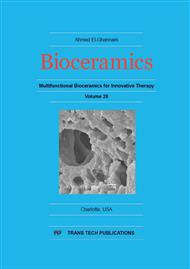[1]
C. Prati, F. Cervellati, V. Sanasi, L. Montebugnoli, Treatment of cervical dentin hypersensitivity with resin adhesives: 4 week evaluation, American Journal of Dentistry. 14 (2001) 378-382.
Google Scholar
[2]
A. Baysan, E. Lynch, Treatment of cervical sensitivity with a root sealant, American Journal of Dentistry. 16 (2003) 135-138.
Google Scholar
[3]
G.E.J. Poinern, R.K. Brundavanam, D. Fawcett, Nanometre scale hydroxyapatite ceramics for bone tissue engineering, American Journal of Biomedical Engineering. 3 (2013) 148-168.
Google Scholar
[4]
N. L D'Elia, C. Mathieu, C.D. Hoemann, J.A. Laiuppa, G.E. Santillan, P.V. Messina, Bone-repair properties of biodegradable hydroxyapatite nano-rod superstructure, Nanoscale. 7 (2015) 18751-18762.
DOI: 10.1039/c5nr04850h
Google Scholar
[5]
A. Stoch, W. Jastrzebski, E. Dlugon, W. Lejda, B. Trybalska, G.J. Scoch, A. Adamczyk, Sol-gel derived hydroxyapatite coatings on titanium and its alloy Ti6Al4V, Journal of Molecular Structure. 744 (2005) 633-640.
DOI: 10.1016/j.molstruc.2004.10.080
Google Scholar
[6]
T. Hayami, S. Hontsu, Y. Higuchi, M. Kusunoki, H. Nishikawa, Osteoconduction of a stoichiometric and bovine hydroxyapatite bilayer-coated implant, Clinical Oral Implants Research. 22 (2011) 774-776.
DOI: 10.1111/j.1600-0501.2010.02057.x
Google Scholar
[7]
Z. Strnad, J. Strnad, C. Povysil, K. Urban, Effect of plasma-sprayed hydroxyapatite coating on the osteoconductivity of commercially pure titanium implants, International Journal of Oral and Maxillofacial Implants. 15 (2000) 483-490.
Google Scholar
[8]
R. Akatsuka, H. Ishihata, M. Noji, K. Matsumura, T. Kuriyagawa, K. Sasaki, Effect of hydroxyapatite film formed by powder jet deposition on dentin permeability, European Journal of Oral Sciences. 120 (2012) 558-562.
DOI: 10.1111/j.1600-0722.2012.01003.x
Google Scholar
[9]
S. Hontsu, K. Yoshikawa, N. Kato, T. Hayami, H. Nishikawa, M. Kusunoki, K. Yamamoto, Restoration and conservation of dental enamel using a flexible apatite sheet, Journal of Australian Ceramic Society. 47 (2011) 11-13.
DOI: 10.4028/www.scientific.net/kem.493-494.615
Google Scholar
[10]
S. Hontsu, N. Kato, E. Yamamoto, H. Nishikawa, M. Kusunoki, T. Hayami, K. Yoshikawa, Regeneration of tooth enamel by flexiblehydroxyapatite sheet, Key Engineering Materials. 493-494 (2012) 615-619.
DOI: 10.4028/www.scientific.net/kem.493-494.615
Google Scholar
[11]
S. Hontsu, K. Yoshikawa, Ultra-thin hydroxyapatite sheets for dental applications, Hydroxyapatite (HAp) for Biomedical Applications, 1st Edition, Edited by M. Mucalo, Woodhead Publishing. (2015) 129-141.
DOI: 10.1016/b978-1-78242-033-0.00006-7
Google Scholar
[12]
E. Yamamoto, N. Kato, A. Isai, H. Nishikawa, Y. Hashimoto, K. Yoshikawa, S. Hontsu, A novel treatment for dentine cavities with intraoral laser ablation method using an Er: YAG laser, Key Engineering Materials. 631 (2015) 262-266.
DOI: 10.4028/www.scientific.net/kem.631.262
Google Scholar
[13]
T. Furumoto, T. Ueda, A. Kasai, A. Hosokawa, Surface temperature during cavity preparation on human tooth by Er: YAG laser irradiation, Manufacturing Technology. 60 (2011) 555-558.
DOI: 10.1016/j.cirp.2011.03.065
Google Scholar
[14]
W.J. Dunn, J.T. Davis, A.C. Bush, Shear bond strength and SEM evaluation of composite bonded to Er: YAG laser-prepared dentin and enamel, Dental Materials. 21 (2005) 616-624.
DOI: 10.1016/j.dental.2004.11.003
Google Scholar
[15]
C. Camerlingo, M. Lepore, G. M. Gaeta, R. Riccio, C. Riccio, A. DeRosa, M. DeRosa, Er: YAG laser treatments on dentin surface: micro-Raman spectroscopy and SEM analysis, Journal of Dentistry. 32 (2004) 399-405.
DOI: 10.1364/bio.2004.thf10
Google Scholar
[16]
M. Mir, J. Meister, R. Franzen, S.S. Sabounchi, F. Lampert, N. Gutknecht, Influence of water-layer thickness on Er: YAG laser ablation of enamel of bovine anterior teeth, Lasers in Medical Science. 23 (2008) 451-457.
DOI: 10.1007/s10103-007-0508-0
Google Scholar
[17]
S.R. Visuri, J.T. Walsh, H.A. Wigdor, Erbium laser ablation of dental hard tissue: effects of water cooling, Lasers is Surgery and Medicine. 18 (1996) 294-300.
DOI: 10.1002/(sici)1096-9101(1996)18:3<294::aid-lsm11>3.0.co;2-6
Google Scholar
[18]
S.M. Park, T. Ikegami, K. Ebihara, Effects of substrate temperature on the properties of Ga-doped ZnO by pulsed laser deposition, Thin Solid Films. 513 (2006) 90-94.
DOI: 10.1016/j.tsf.2006.01.051
Google Scholar
[19]
P. Hu, B. Li, L. Feng, J. Wu, H. Jiang, H. Yang, X. Xiao, Effects of substrate temperature on the properties of CdTe thin films deposited by pulsed laser deposition, Surface and Coatings Technology. 213 (2012) 84-89.
DOI: 10.1016/j.surfcoat.2012.10.022
Google Scholar
[20]
S.A. Corona, A.E. Souza-Gabriel, M.A. Chinelatti, J.D. Pecora, M.C. Borsatto, R.G. Palma-Dibb, Influence of energy and pulse repetition rate of Er: YAG laser on enamel ablation ability and morphological analysis of the laser-irradiated surface, Journal of Biomedical Materials Research. Part A. 84 (2008).
DOI: 10.1002/jbm.a.31335
Google Scholar
[21]
S.A. Corona, A.E. Souza-Gabriel, M.A. Chinelatti, M.C. Borsatto, J.D. Pecora, R.G. Palma-Dibb, Effect of energy and pulse repetition rate of Er: YAG laser on dentin ablation ability and morphological analysis of the laser-irradiated substrate, Photomedicine and Laser Surgery. 25 (2007).
DOI: 10.1089/pho.2006.1075
Google Scholar


